by C.E. Swift * (12/14)
Quick Facts…
- A lack of adequate nutrients affects tree growth and fruit production.
- Fruit trees can be fertilized with nitrogen fertilizer based on their annual growth rate or a soil analysis.
- Most fruit trees require a yearly foliar spray of zinc.
- A soil analysis can determine other nutrients needed by fruit trees.
- Applying nutrients that are not needed can cause a nutrient imbalance.
Introduction
Fruit trees are fertilized to ensure continued growth and fruit production. In the backyard orchard, proper pruning in addition to the application of nitrogen in the spring prior to or at bud break helps maintain this productive status. Other than nitrogen and zinc, iron and manganese may limit growth due to our alkaline soil conditions. Apply nutrients based on a soil test analysis conducted by the soil testing lab at Colorado State University or another analytical lab of your choice.
The amount of nitrogen to apply can be based on how much shoot growth occurred the previous season or on a soil analysis. Reduced fruiting wood and reduced fruit production results when the growth rate is less than what is recommended in Table 1.
Table 1: Annual Growth Rate.
|
Nonbearing Trees
|
Last Year’s Annual Growth Rate
|
| Apple | 12 to 36 inches |
| Pear | |
| Peach & Nectarine | |
| Tart Cherry | |
| Plum & Sweet Cherry | |
|
Bearing Trees
|
|
| Apple Non-Spur | 6 to 18 inches |
| Apple Spur-type | 6 to 10 inches |
| Pear | 12 to 16 inches |
| Peach & Nectarine | 12 to 18 inches |
| Tart Cherry | ~ 8 inches |
| Plum & Sweet Cherry | ~ 8 inches |
Identifying Annual Growth
Each year of growth can be identified by the ring of bud scale scars remaining when the bud at the tip of the shoot grows. A difference in color and/or bark texture is typically evident above and below the annual growth ring. Check last year’s annual growth rate at several points around the tree to determine the average length of last year’s growth. Use the average length of annual growth to determine if and how much nitrogen should be applied.
Applying Nitrogen Based on Annual Growth Rate
Stone fruit trees (i.e. peach, cherry, plum and nectarines) can be fertilized at a maximum rate of 1/8 pound of nitrogen per inch of trunk diameter (measured 1 foot above ground level). Apply this amount if the tree’s annual growth is on the low end of the recommendation given in Table 1. Apply less fertilizer if the previous season’s growth rate falls in between the recommended growth increments. If too much nitrogen is applied it can lead to excessive leaf and tree growth over fruit production.
The maximum rate of nitrogen to apply to pome fruit trees (apples and pears) is 1/10th pound of nitrogen per inch of trunk diameter (measured 1 foot above ground level). Apply this amount if growth the previous year was at the low end of the recommended rate. As with stone fruits, apply less nitrogen the closer the actual growth rate approximates the recommended growth rate.
Maintain a record on the amount of nitrogen applied each year and the resulting growth. Such records provide a guide for the amount of nitrogen fertilizer to apply to achieve the desired results.
Applying Nitrogen Based on a Soil Analysis
If a soil analysis has been conducted, the recommendations in Table 2 indicate the amount of nitrogen to apply.
Table 2: Nitrogen requirements based on a soil test.
| Soil Test Value NO-3N ppm | Pounds of Nitrogen to apply per 1,000 square foot area when percent organic matter is: | ||||||
|
0-0.5
|
0.6-1.0
|
1.1-1.5
|
1.6-2.0
|
2.1-2.5
|
2.6+
|
||
| 0.0-3.0 |
4.1
|
3.8
|
3.4
|
3.1
|
2.8
|
2.1
|
|
| 3.1-6.0 |
3.9
|
3.6
|
3.2
|
2.9
|
2.5
|
1.8
|
|
| 6.1-9.0 |
3.7
|
3.3
|
3.0
|
2.6
|
2.3
|
1.6
|
|
| 9.1-12.0 |
3.4
|
3.1
|
2.8
|
2.4
|
2.1
|
1.4
|
|
| 12.1-15.0 |
3.2
|
2.9
|
2.5
|
2.2
|
1.8
|
1.1
|
|
Note: The above information is specific to apples and pears. Add 0.2 pounds per 1,000 square foot area for peaches, nectarines, apricots and plums and 0.4 pound per 1,000 square foot area for cherries.
Calculating the Amount of Fertilizer Applications
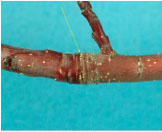 |
| Figure 1: Annual Growth Ring –Apple |
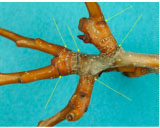 |
| Figure 2: Annual Growth Ring – Pear |
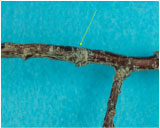 |
| Figure 3: Annual Growth Rings – Apricot |
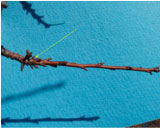 |
| Figure 4: Annual Growth Ring – Sweet cherry |
 |
| Figure 5: Annual Growth Ring – Peach. |
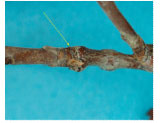 |
| Figure 6: Annual Growth Ring– Italian Plum |
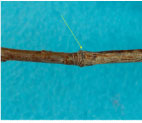 |
| Figure 7: Annual Growth Ring – Santa Rosa Plum. |
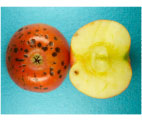 |
| Figure 8: Bitter-pit and cork spot on Honeycrisp apple. |
Fertilizer products contain specific quantities of nutrient based on percentage by weight. This is indicated on the product label such as 15-1-1. The first number (15) is the percentage by weight of nitrogen, the second number is the percentage by weight of phosphorus (P2O5) and the third is the percentage by weight of potassium (K2O). For example, ammonium sulfate (21-0-0) contains 21 percent nitrogen while blood meal contains 12 percent to 13 percent nitrogen. The amount of the fertilizer product needed is calculated by dividing the pounds of nutrient needed by the percent of that nutrient in the product.
For example, if you need 1/2 pound of nitrogen for a given area and are using a product with 15 percent Nitrogen, divide .5 (one-half pound) by .15 (the percent of N in the product). This tells you 3.33 pounds of this product are needed to apply 1/2 pound of nitrogen.
Pruning and Excessive Irrigation
Pruning the same amount each year will result in the same amount of stimulated growth. If the tree is pruned more severely, apply less nitrogen fertilizer. This will help avoid excessive growth.
Irrigating too frequently or too much at one time, as is common with fruit trees planted in turf areas, stimulates growth and subjects fruit trees to possible root rot diseases. Take into account excessive irrigation and correct if possible. Eliminating the grass around the base of a fruit tree and applying a thin layer of mulch is recommended. Kill the grass with a glyphosate product, horticultural vinegar or fatty acid product such as Scythe before applying mulch.
It is highly recommended to plant the backyard fruit orchard away from turf where the trees can be watered and fertilized based on their needs and not that of turfgrass
Calcium
Bitter-pit and cork spot in apples (Figure 8) is a direct result of the inability of the tree to move adequate calcium into the fruit. Small brown lesions up to ½ inch (10 mm) in diameter appear on the fruit. The area below the skin becomes dark and corky. These spots may appear at harvest or during cold storage. Young vigorous trees with few fruit and trees that are over irrigated and over fertilized are more susceptible to this disorder. Calcium sprays are formulated by adding calcium chloride to water at the rate of 3 to 4 pounds per 100 gallons or 0.63 ounces per gallon of water (see Fact Sheet no. 7.615, The Preparation of Small Spray Quantities of Pesticides.) Apply the first spray about mid-June, a second in mid-July, and a third in mid-August. Trees not affected by this condition will not need this treatment.
Iron
Iron deficiency symptoms result in the leaves at the end of the branch being yellow or light green with a network of deep green veins. Margin leaf burn may be evident. This deficiency often results in reduced fruit yields and poorly colored fruit with a flat taste. Apply chelated iron at the rates recommended in Table 4. To help correct this problem, avoid over irrigation and improve the organic content of the soil.
Zinc
Zinc deficiency symptoms are common in Colorado. Since soil applications of zinc have not proven effective, the application of a zinc spray prior to bud break in the spring is recommended. However, applications made within three days (five days for apples) before or after an application of horticultural or dormant oil can cause injury and should be avoided. In this case, except for apricots, apply the zinc in the fall, after October 10. Mix 1 tablespoon of zinc sulfate in a gallon of water. Thoroughly cover the tree with the spray and apply the spray until the bark is no longer able to hold the spray and spray runs off the tree.
Other Nutrients
Other than the application of nitrogen and zinc as described above, base the application of the other nutrients on the results of a soil analysis. Foliar sprays of micronutrients can give remediation for the season if started in April-May and continued until June-July. Miracle-Gro, or a similar water soluble fertilizer can be used for this treatment. Read and follow the label directions on the fertilizer container.
Placement of Fertilizer
Nitrogen (N) and other nutrients, with the exception of zinc, can be broadcast over the ground and watered in, or applied in a band in the irrigation furrows prior to irrigation. Do not apply fertilizer against the trunk as tissue damage may result. Spread the fertilizer evenly and do not dump it in a pile at the base of the tree or injury will result. If the area to be fertilized is more or less than 1,0002 feet, calculate the amount of fertilizer to apply accordingly. Foliar applications can also be used if appropriate materials are chosen.
Table 3. Phosphorus needs based on the extraction method used.
| Phosphorus level of sufficiency ppm | AB-DTPA ppm | Bray-1 & Mehlich-II ppm | Mehlich-lll ppm | Olsen ppm | Apply P2O lbs/10002ft. |
| Very low to Low | 0-7 | 0-12 | <10 | 0-9 | 3.5 |
| Medium | 7.1-13 | 13-25 | 11-31 | 10-16 | 2.9 |
| High | 13-22 | 26-50 | 32-56 | 16-31 | 2.3 |
| Sufficient | <23 | >50.1 | >56.1 | >31.1 | 0 |
Note: The Phosphorus extraction method used may be noted on the soil test results. If not, contact the lab to determine what method was used.
Table 4: Soil test results and recommendations.
| Potassium ppm | Apply K20 lbs/10002 ft. | AB-DTPA extractable iron Fe ppm | Chelated Fe *(Sequestrene 138-Fe) lbs/10002 ft |
| 0-60 | 1.8 | 1.8 Low -2.0 | 3.5 |
| 61-20 | 0.9 | Marginal 2.0-4.5 | 1.7 |
| 121-200 | 0 | Marginal 2.0-4.5 | 0 |
| 201 + | 0 |
Note: Sequestrene 138 Fe is 6 percent iron. Other chelated iron products may not be effective in high pH soil
References
Childers, N.F. 1978. Modern Fruit Science. Rutgers University.
Follett, R.H. and D.G. Westfall. 2004. Zinc and Iron Deficiencies, Colorado State University Extension Fact Sheet 0.545
Larsen, H.J., A.G. Gaus, R.J. Zimmerman, M. Rogoyski. 1998. Colorado Tree Fruits: Pest and Crop Management Guide. Colorado State University Extension bulletin XCM-41.
Stacey, J.K. 1972. Orchard Management Workshop Proceedings, Cedaredge High School
Westwood, M.N. 1978. Temperate-zone Pomology. W.H. Freeman and Company.
Additional fact sheets on fruit trees and their care include:
- 2.804, Backyard Orchard: Stone Fruits.
- 7.615, The Preparation of Small Spray Quantities of Pesticides.
- 5.507,Spider Mites.
- 5.560, Pear Slugs.
- 5.569, Insect Control: Horticultural Oils.
1 C.E. Swift, former Colorado State University area Extension agent, horticulture, Tri River Area, Grand Junction. 7/09. Revised 12/14.
Colorado State University, U.S. Department of Agriculture, and Colorado counties cooperating. CSU Extension programs are available to all without discrimination. No endorsement of products mentioned is intended nor is criticism implied of products not mentioned.
Go to top of this page.





